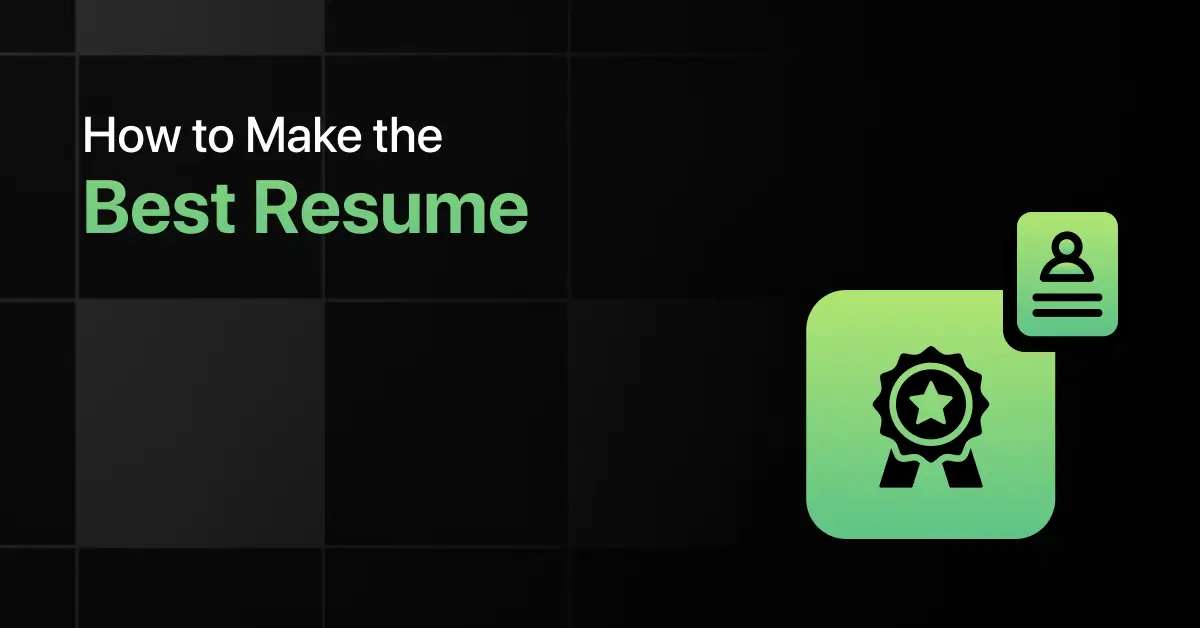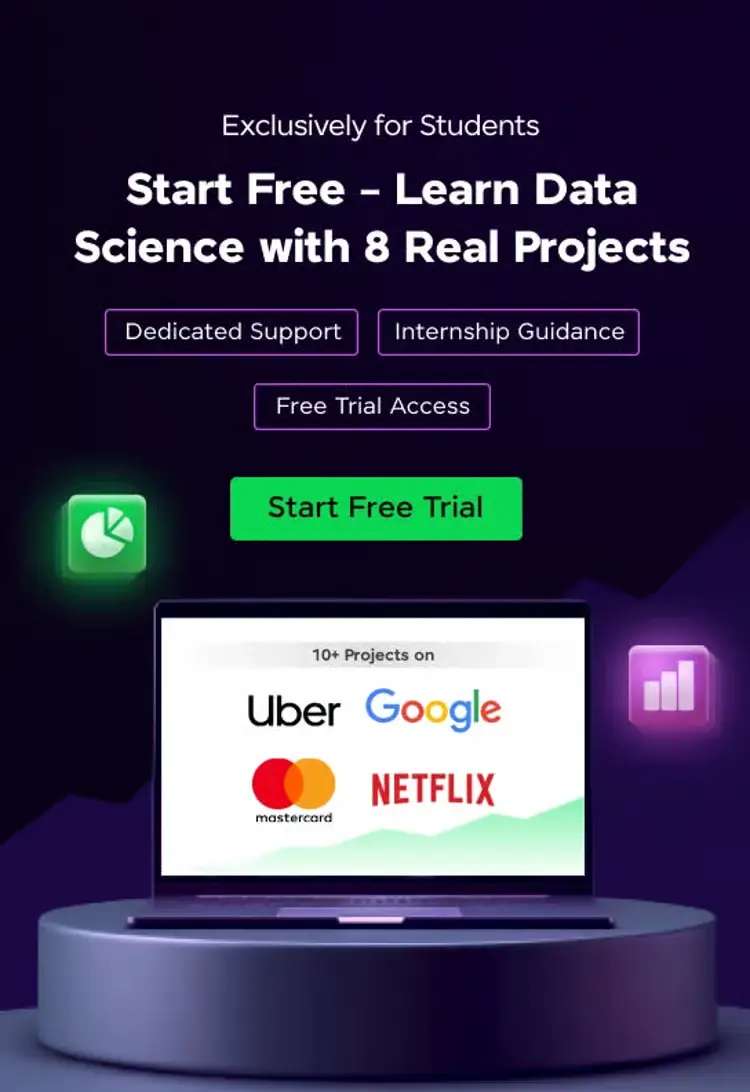How to Make the Best Resume For Any Job

Struggling to get noticed by recruiters? The problem may not be your skills but your resume. Freshers are anxious about what to write in a resume when they lack experience. Professionals end up with lengthy, disorganized resumes. Selecting an appropriate resume format is confusing. People are unaware of how to make a resume for a job application.
Generic goals, inadequately showcased skills, and resumes that don’t function effectively with ATS are rejected even before they come to recruiters. Uncertainty also exists regarding the resume length, the lack of relevant keywords, and the lack of customization for the specific job position.
This guide will show you step by step how to make the best resume that stands out, gets shortlisted, and moves you closer to your dream job.
The Exact Process For Creating The Best Resume
Everyone is making a resume by covering pages with all the information in their career, but what makes the best resume is balance and strategic planning. The secret of the best resume lies in three things: developing a clear structure in the appropriate format and flow, presenting your most applicable skills, achievements, and education, and lastly, customizing the material for every job position.
When the three components are combined together, you have a professional resume, ATS-friendly, and strong enough to grab a recruiter’s eye.

Here are the key steps you should follow to create the best, job-ready resume that highlights your skills and grabs recruiter attention:
1. Choosing the right resume format/template
- Pick the right resume-making format: Chronological, Functional, or Combination formats.
- Freshers can use functional formats, while professionals need chronological layouts.
- The best resume-making format should have balance, clarity, and ATS readability.
- Keep fonts simple (Arial, Calibri, Times New Roman) and avoid decorative designs that may confuse ATS.
2. Prepare for your information
Before you begin resume preparation, organize details to avoid missing critical information:
- Personal Information: Full name, phone number, professional email ID, LinkedIn profile, portfolio (if relevant).
- Education: Degrees, university/college, graduation year, GPA (if strong), certifications, and relevant coursework.
- Experience: Internships, part-time jobs, freelance work, or projects. Always include your role, organization, and duration.
- Skills: Split into technical skills (e.g., Python, SQL, Photoshop) and soft skills (e.g., teamwork, communication).
- Additional Info: Extracurricular activities, volunteer work, or publications, if they strengthen your application.
This preparation prevents missing critical data when you start to create a resume.
3. Create your ‘about me section / Objective / Summary’
- This is where most people get stuck on how to make the best resume is what to write in a resume. This section should communicate your career direction. Write 2–3 lines about who you are and what you aim for.
- For Freshers: Focus on skills, education, and learning goals.
Example: “Computer Science graduate skilled in Python and SQL, seeking to start a career in data analytics with a focus on data-driven problem solving.” - For Professionals: Highlight career achievements and specialization.
Example: “Marketing specialist with 5+ years’ experience in digital campaigns, driving 40% ROI improvements and leading cross-functional teams.” - Avoid vague phrases like “hardworking individual looking for growth.” Make it specific and tailored.
4. Adding Education Qualification
Education is a must-have when learning how to write a resume.
- List your degrees in reverse chronological order (latest first).
- Mention university/college name, degree, major, and year of completion.
- Add certifications, short courses, or MOOCs relevant to the role.
- Highlight achievements such as scholarships, top ranks, or academic projects.
- Keep formatting consistent:
Example 1: B.Tech in Computer Science, Anna University – 2022
Example 2: Google Data Analytics Certification – 2023
5. List Work Experience
- For professionals, this section is the backbone of how to create a resume.
- Start with the most recent role and work backwards.
- For each role, include:
Job Title
Company Name
Duration (Month/Year – Month/Year)
Location (optional) - Focus on achievements over responsibilities. Use action verbs (boosted, implemented, developed).
- Quantify results wherever possible:
Example: “Sales Associate – XYZ Corp (2022–2023): Boosted monthly sales by 18% through client relationship strategies and targeted campaigns.” - If you are a fresher, replace work experience with internships, academic projects, or freelance work.
6. Highlighting Skills and Achievements
- Skills sections are key for how to make a professional resume.
- Include both technical skills (coding, tools, languages, software) and soft skills (leadership, communication, problem-solving).
- Always match your skills with the keywords in the job description.
- Add achievements like awards, recognitions, or major contributions.
Example:
- Proficient in Python, SQL, Tableau
- Awarded “Best Team Player” at XYZ Corp – 2023
- Led a 5-member project team delivering a software solution ahead of deadline
7. Make Your Resume ATS-Friendly
- Use standard section headings (Work Experience, Education, Skills).
- Avoid images, icons, tables, or unusual fonts. ATS often rejects these.
- Insert relevant keywords naturally in your descriptions.
- Focus on measurable achievements:
Instead of: “Did reports”
Write: “Prepared data-driven reports using Power BI and Excel, improving reporting efficiency by 25%.” - Save resumes in PDF or Word (.docx) format unless otherwise specified.
8. Tailoring a Resume for Specific Job Roles
- A crucial part of how to make a resume for job applications is customization.
- Never send a generic resume; always adjust it per application.
- Rewrite your summary/objective to reflect the role.
- Highlight skills relevant to the job description.
- Use keywords from the job posting to show alignment.
Example:
For a software engineering role, your emphasize should be coding skills, projects, and frameworks.
For a management role, highlight soft skills like leadership, communication, and project management.
9 . Deciding Resume Length (1 Page vs 2 Pages)
- Knowing how to write a resume also means knowing when to stop.
- Freshers/Early Career (0–3 years) → Stick to 1 page. Focus on education, internships, and projects.
- Mid-Senior Professionals (4–10 years) → 2 pages is acceptable if showcasing multiple roles and achievements.
- Senior Leaders (10+ years) → 2 pages maximum. Highlight major career milestones, not every detail.
- Golden Rule: Prioritize quality over quantity. Only include information that strengthens your candidacy.
Example:
- Fresher with 2 internships = 1 page ideal.
- Professional with 7 years across 3 companies = 2 pages suitable.
Ready to apply these steps? Don’t waste time formatting. Use HCL GUVI’s Free Resume Builder to make an ATS-approved resume instantly, and run it through the Resume ATS Score Checker before sending it to recruiters.
Quick Checklist Before Sending Your Resume
| Checklist Item | Why It Matters |
|---|---|
| Is your resume one page? | Recruiters prefer concise resumes. One Page is more than enough for freshers unless you have extensive internships or certifications. |
| Exported as PDF with no layout shifts | Word/Docs files can break formatting on different devices. PDFs keep your resume neat and professional. |
| Highlighted projects, skills, certifications | Projects, skills, and certifications matter more than work experience for freshers. Keep them visible and well-structured. |
| Proofread and grammar-checked? | Typos and grammar errors show carelessness. Use tools like Grammarly and get a second review from a mentor. |
| ATS-friendly format (clear headings, no graphics) | Applicant Tracking Systems reject resumes with complex designs. Stick to simple fonts, bullet points, and clear section headers. |
| Career Objective should be up to the job | A customized 2–3 line objective helps recruiters see your career goals and fit for the role. Avoid generic lines. |
Final Words
Now you know how to make the best resume, from preparing content to customizing it for jobs. A proper resume is structured, concise, and highlights what makes you employable. Apply these steps, and you’ll stand out in every job application.
Don’t wait until the last minute, start creating your professional, ATS-ready resume today with these free online resume builders.
Frequently Asked Questions
1. How to make the best resume for job applications?
Choose the right format, match your skills with the job description, and keep it ATS-friendly.
2. Which resume format works best for experienced professionals?
The chronological format highlights career growth and achievements.
3. What sections should be included in the best resume?
Header, Objective, Education, Experience, Skills, and Achievements.
4. How many skills should be added to make a resume impactful?
Include 5–8 strong skills related to the target job.
5. How do I tailor my resume for specific job roles?
Rewrite the summary, highlight role-relevant skills, and adjust projects/experience to fit the job.
6. What common mistakes should I avoid to make the best resume?
Avoid typos, cluttered formatting, irrelevant details, and exceeding the recommended length.
Explore More Resume Articles
Related Posts


Roadmap for Learning Data Structures & Algorithms
Feeling confused about where to start and what to learn first in DSA? Many learners struggle not because DSA is …
Warning: Undefined variable $post_id in /var/www/wordpress/wp-content/themes/placementpreparation/template-parts/popup-zenlite.php on line 1050








